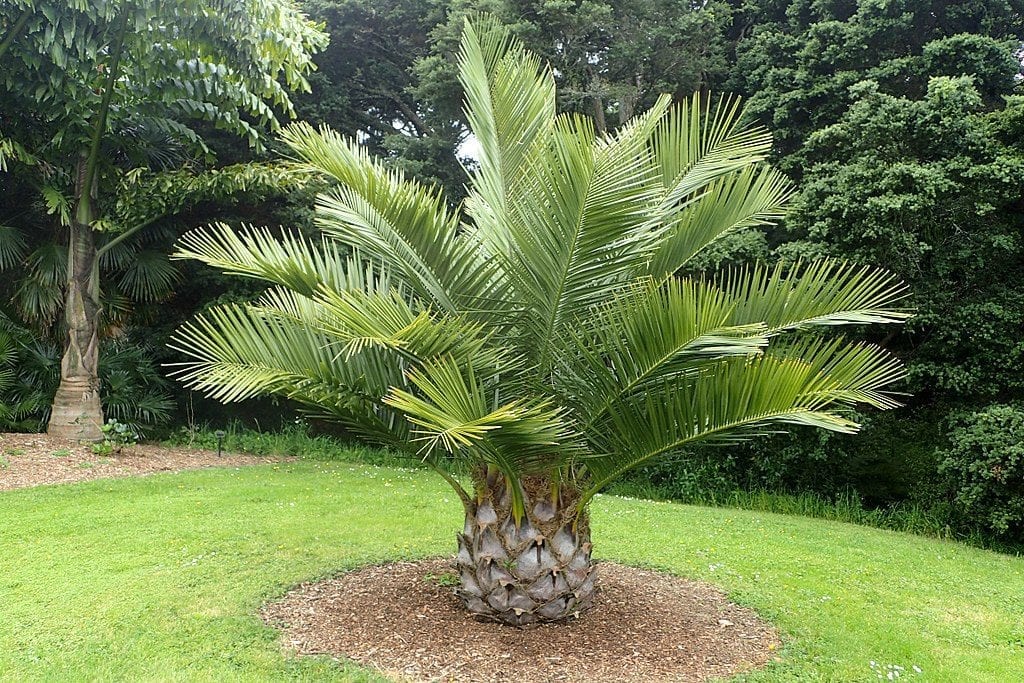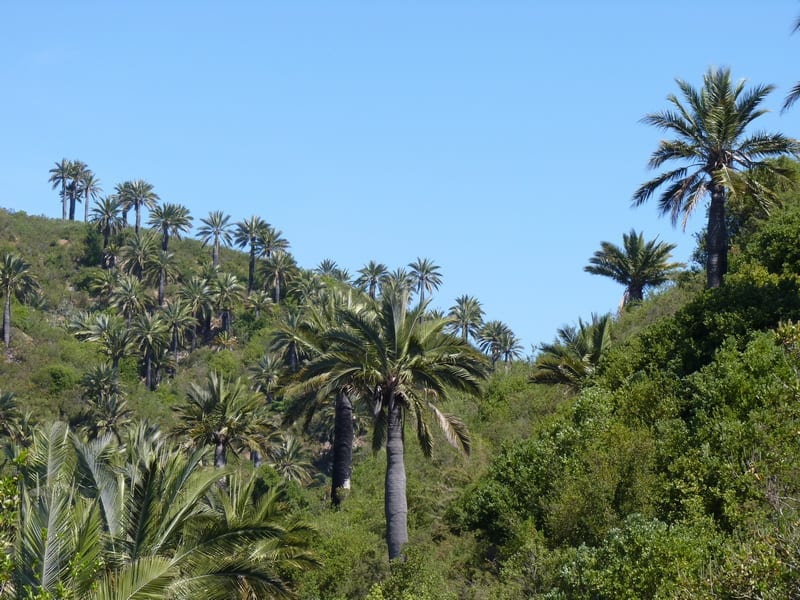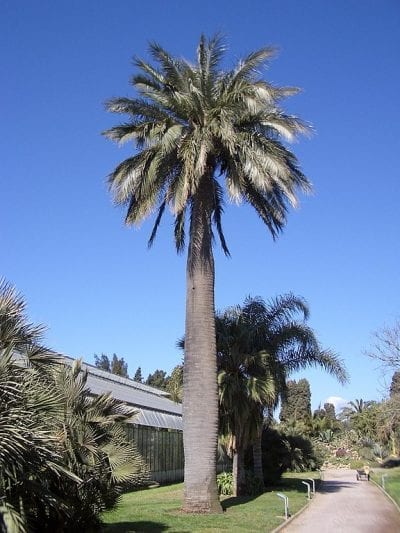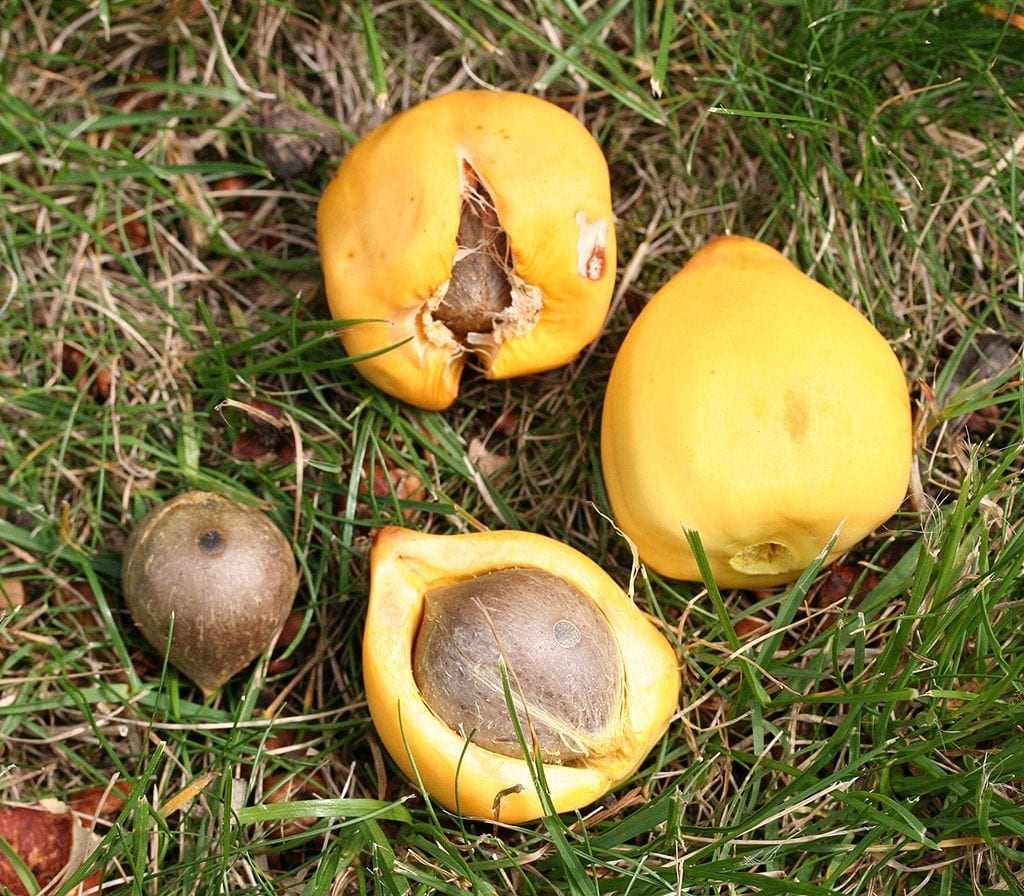
La Jubaea chilensis It is a slow growing palm tree, but it is so pretty and rustic that I sincerely think it should be given a chance in all gardens, medium to large. Its pinnate leaves have the elegance of tropical palm trees, and its trunk, although thick, is highly stylized.
Its easy maintenance makes it one of the most interesting species, since with a minimum care we can have a spectacular plant. Do you want to know what they are?
Origin and characteristics

Our protagonist is a palm native to southwestern South America, where it is endemic to a small area of central Chile that corresponds to the Coquimbo Region, the Valparaíso Region, the Santiago Metropolitan Region, the O'Higgins Region and the Maule Region. Its scientific name is Jubaea chilensis, and is known by its common names Chilean palm, honey palm, coconut palm, can-can or lilla.
It reaches a height of 30 meters, with a thick trunk composed of fibers that can thicken up to 1,3 meters at the base. The leaves are pinnate, 3 to 5 meters long and are composed of linear-lanceolate leaflets with a glaucous underside and measure up to 0,60m. The flowers are grouped in interfoliar inflorescences protected by a spathe, and are unisexual. The fruit is yellow in color and measures about five centimeters when ripe.
It has a very slow growth rate, growing a maximum of 20 centimeters per year reaching 6 meters with 40 or 50 years of age.
What are their cares?

If you want to have a copy, we recommend that you provide it with the following care:
Location
La Jubaea chilensis it is a palm tree that it must be placed outside, in full sun. It does not have invasive roots, but for it to have a good development it must be planted at least 2 or 3 meters from paved soils, houses, etc.
Earth
- Garden: grows in all types of soils as long as they have good drainage. In the event that the soil on your land does not have good water filtration capacity, make a 1m x 1m hole and mix it with perlite (you can get it here) in equal parts.
- Flower pot: it can be kept for several years in a pot with a universal growing medium (you will find it on sale here) mixed with 30% perlite.
Irrigation
It is a palm tree that does not tolerate waterlogging. Being adapted to living in an area with a Mediterranean climate, which is characterized by very hot and dry summers, it is not necessary to water it a lot, otherwise its roots would rot immediately. Thus, It is highly advisable to check the humidity of the soil, for example by doing some of these things:
- Use a digital moisture meter: as soon as you insert it, it will tell you how wet the soil that has come into contact with the meter is. To be much more reliable, it is important that you reinsert it but further / closer to the plant.
- Dig about 10 centimeters around the palm tree: the soil on the surface dries very quickly, but the soil just below it does not. Therefore, nothing better than digging a little around the plant to see if it is really wet or not.
- Weigh the pot once watered and again after a few days: this can only be done when the plant is young, of course, but since dry soil weighs less than wet, this will serve as a guide to know when to water and when not.
Subscriber
From early spring to summer (you can also in autumn if you live in a mild climate) it has to be paid with ecological fertilizers, once a month. From experience I advise you to use the guano, since it is rich in nutrients and its effectiveness is very fast. You can get it liquid (for pots) here and powder here.
Multiplication

La Jubaea chilensis multiplies by seeds in spring. The step by step to follow is as follows:
- The first thing to do is put them in a glass of water for 24 hours. Those that remain floating can be discarded since they will not be viable.
- Then a pot is filled with universal growing medium mixed with 30% perlite, and watered.
- Next, the seeds are placed leaving a separation of about five centimeters between them, and they are covered with a layer of substrate thick enough so that they are not directly exposed to the sun.
- Finally, it is watered again, this time with a sprayer, and the pot is placed outside, in full sun.
They will take a long time to germinate: from 4 months to a year.
Plagues and diseases
It is quite resistant, but especially when it is young it can be affected by:
- Mealybugs: they can be cottony or limpet-like. They feed on the sap of the leaves, but can be avoided with an anti-mealybug insecticide.
- Grasshoppers and locusts: they feed on the leaves. It can be avoided with these remedies.
- Mushrooms: if it is watered in excess they will appear. You have to control the risks and treat with fungicide if you have run out of water.
Rusticity
Withstands cold and frost well up to -20ºC. It also withstands high temperatures of up to 35-38ºC.
What uses does it have?
Apart from being used as an ornamental, has other uses:
- The rind of the fruit is edible. It can be eaten fresh but is also used in confectionery.
- With the leaves they used to make houses next to the adobe, and it was also used for hats and decorations.
- The sap is extracted to make a very sweet honey, but only in the palm groves intended for them.
It is a palm tree in serious danger of extinction due to loss of habitat and uncontrolled use, so it is important that it is used only as a decorative plant.

What did you think of Jubaea chilensis?
Very good summary. I am excited about this palm. I have 3 of about 60 cm. and 3 newer ones are coming on the way a little bigger.
I planned to plant them 1 meter from a wall and 1.5 mt. of a wooden deck. If it does not have invasive roots, why should you plant it 2 or 3 meters from a building?
Hello José Miguel.
It is recommended to plant it a little far away for a question of size. The adult trunk is thick (1,50m in diameter), and its leaves can easily measure 3-4 meters.
If it were very close to a wall, it would grow tilted, or it could even fall.
regards
INTERESTING INFORMATION, AS HIS NAME JUBAE CHILENSIS SAYS, WE ALL SHOULD HAVE ONE OF THESE PALM TREE IN OUR SURROUNDINGS.
A PAIR OF THESE SHOULD BE IN EVERY NATIONAL SQUARE.
MAGNIFICENT PALM TREE
It is very pretty, without a doubt. It should be cultivated more.
Excellent article. Thanks a lot.
Where can small healthy specimens be purchased in the fifth region?
Hello Sergio.
Thanks. But where are you from? It is that we are in Spain.
In any case, I recommend you ask in plant nurseries in your area, or in online stores.
Greetings.